
scrounge: /skrounj/ informal verb: to actively seek [books] from any available source
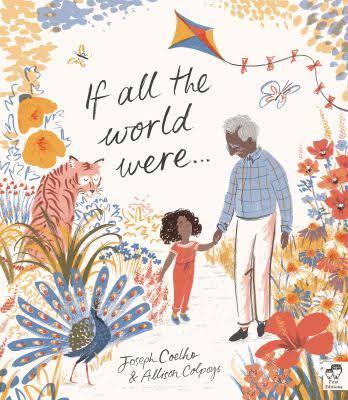
If all the world were springtime
I would replant my grandad's birthdays
So that he would never get old.
If All the World Were... is a beautifully illustrated poem about a girl's relationship with her grandfather, encompassing both her joy as she spends time with him, and her sadness at his eventual passing.
Tracing life through the seasons of one year, the story finds beauty in simplicity, the small joys of simply being together and doing things. Without using a lot of words, it communicates love and memories, each memory represented by a small token that relates to the day they spent together.
This one got me a little teary -- it's very sweet and even in the sadness, celebrates the joy of good memories. The colors in the illustrations are also lovely.
(Thanks to NetGalley for the review copy.)
Scrounged From: NetGalley
Format: Kindle
Author: Joseph Coelho
Illustrator: Allison Colpoys
Pages: 32
Content Advisory: Obviously, this book deals with loss and is sad (but also happy). No specifics the illness/dying process are mentioned.
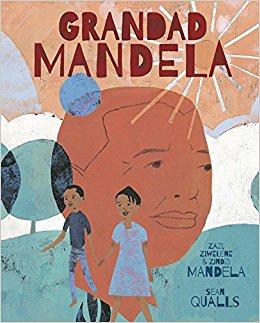
Grandad Mandela serves as a wonderful introduction to the life and legacy of Nelson Mandela, who brought an end to racial apartheid while president of South Africa.
The book is written as a conversation between the book's author, Zindzi Mandela, who is Nelson Mandela's daughter, and her two grandchildren, Zazi and Ziwelene. While the conversation primarily serves to structure the narrative, it also brings a sense of familial connection and pride to Mandela's story.
In order to adequately cover the major events of Mandela's life, the story also explains important concepts from that time and place that might not make as much sense to children these days, such as apartheid, justice (especially as it related to apartheid), and the African principle of "Ubuntu" -- treating others as we would want to be treated, and in Mandela's case, forgiving his enemies in order to work with them for the betterment of the entire country.
In addition to the thorough (without being too wordy) and important story, the illustrations here are wonderful -- they capture the view of Mandela as a single, important person, but also his fight for justice and the way it encompassed an entire country -- and the colors are wonderful too.
This is a great way for children to learn about an important historical figure, and for those of us who are older, it can serve as a jumping-off point for further reading.
(Thanks to NetGalley for the review copy.)
Scrounged From: NetGalley
Format: Kindle
Author: Ambassador Zindzi Mandela, Zazi and Ziwelene Mandela
Illustrator: Sean Qualls
Pages: 40
Content Advisory: Very little is actually said of violence ("fight" is generally used as a more theoretical term, implying the general fight for justice), but there is one scene that depicts two white policeman with sticks raised over two black people who are on the ground -- no blood, but it gives a visual of the racial dominance that was upheld under apartheid. There is mention of Mandela's long prison term, and how difficult it was to keep his spirits up.
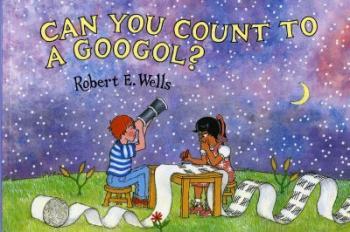
A while ago, in this post, I wrote about some titles in Robert E. Wells' science series that we've really enjoyed. We've since read a few more books from this series that we've enjoyed just as much, so I decided we needed a "part two."
The first is Can You Count to a Googol?, which uses creative illustrations and simple mathematical concepts to introduce students to progressively larger numbers -- from one, to ten, to one hundred (with the reminder that each zero at the end makes a number ten times bigger), to even more. The visualizations include baskets full of marshmallows, penguins eating many scoops of ice cream, and dollar bills packed onto pallets. The end blew our minds a bit as we tried to understand just how big a googol is (one with one hundred zeroes after it). Even then, the reminder that numbers never end gives a lot of perspective as we contemplate outer space and other things so much bigger than us. This book is similar to How Much Is a Million?, a memorable Reading Rainbow book, but I appreciate that this one walks us through even larger numbers and is more clear about how to get from one to another.
The next is Did a Dinosaur Drink This Water?, which is a very thorough exploration of the water system (dinosaur-loving kids may be disappointed to find out that this isn't really about dinosaurs, but it does emphasize how water molecules have been recycled over and over for a very long time). Since it mentions water molecules, this might be an interesting follow-up to What's Smaller Than a Pygmy Shrew? It covers fresh vs. salt water, how water is naturally cleaned and filtered, evaporation and rain, hydroelectricity, and also a bit about conservation at the end, which actually follows well from the text and doesn't feel "tacked on" like these things sometimes do.
Lastly, we've also enjoyed How Do You Know What Time It Is?, which is one of the more thorough titles we've read since it covers aspects of both science and history, and it may be harder for younger children to follow. But it does a great job introducting children to the concept of time, and how we don't even really know what it is. The history comes in when it discusses many of the earlier methods that people used to measure time, such as sun dials, water clocks, and solar vs. lunar calendars. From there it goes into earth's rotation and orbit, as well as time zones and other complications of measuring time. I appreciated the science and history, but also the straightforwardness about mystery, and how much science still hasn't been able to tell us about many concepts, such as time.
Scrounged From: Our local library and AbeBooks.com
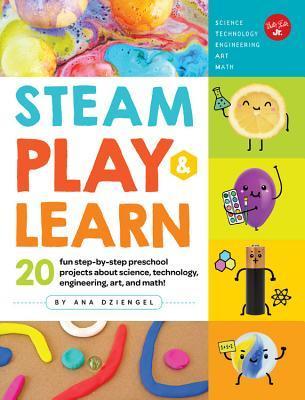
With vibrant photos and cute, colorful illustrations STEAM Play & Learn provides a bunch of fun activities for preschool or early-elementary-age children. Whether it's making a colorful volcano out of a lemon, a battery out of a lime, or giant building blocks from lunch bags and crumpled newspaper, this book includes activities that encourage problem-solving and engineering, but many also involve creative and artistic elements too.
The activities are grouped based on difficulty: easy, medium, and difficult. Some involve a lot of adult prep including hot-gluing and using tools (though the "Newton's Cradle" out of popsicle sticks does seem pretty cool!), but fortunately most fall into the "easy" category, and some can even be done with common household items. Food coloring is a common ingredient, as well as marbles, clay, baking soda, etc.
I've already gathered some inspiration on making building materials out of cardboard tubes with holes punched in them and straws (though we used pipe cleaners instead), and the "goop" recipe looks like it will be a fun thing to do outside in the summer.
It looks like there will be something here for everyone with young kids, whether you just want something quick and easy for preschoolers, or feel like tackling a multi-step activity for older kids, and each one includes some information about the particular scientific principles that are at work, plus each one looks like it would be a lot of fun.
(Thanks to NetGalley for the review copy.)
Scrounged From: NetGalley
Format: Kindle
Author: Ana Dziengel
Pages: 80
Content Advisory: None
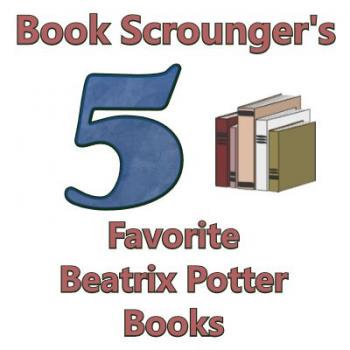
Beatrix Potter books are classics that many of us grew up with -- I can remember bits and pieces of them from early on, especially from a large treasury we had. One thing I notice is how different they are from your typical picture books nowadays -- while the animals are very much anthropomorphized, they display a more shrewd and realistic view of the dangers of life than books tend to now. More than one of these stories involves an animals barely escaping from death at the hands of another animal.
Of all the Potter books I've enjoyed, here are my five favorites (in no particular order):
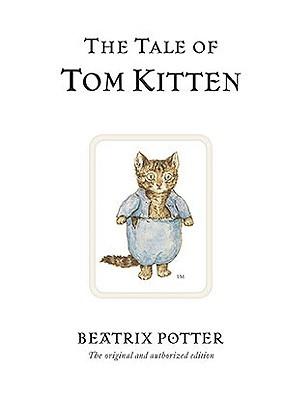
1. Tom Kitten appears to be a story about the perils of trying to dress kittens up in human clothes, as attempted by a mother cat who also wears human clothes -- so perhaps it's really just about the boundless curiosity of children that refuses to be contained with pieces of frippery. Either way, I find it amusing in its matter-of-fact descriptions of how the whole affair falls apart. I've also included this in my 5 picture books featuring cats list.
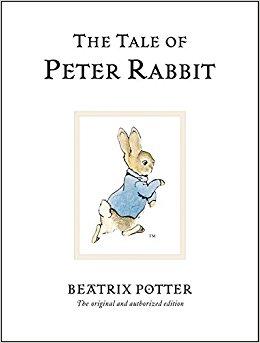
2. Peter Rabbit pretty much IS Beatrix Potter, as far as many of us know. So much so that it can be hard to find a basic, original copy of this story since it's been adapted into so many other forms since it's been published. He's become a nursery theme, stuffed animals, and apparently a movie now, the idea of which I find even more terrifying than Mr. McGregor. Full review here.
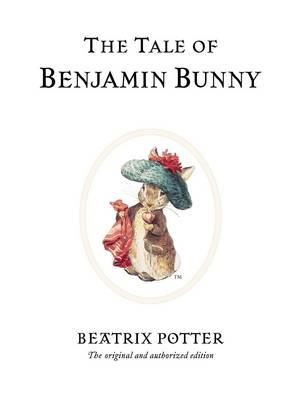
3. Benjamin Bunny is the follow-up to Peter Rabbit, and involves an amusing contrast between the optimistic inexperience of Benjamin vs. the wide-eyed PTSD of Peter. Their experience in McGregor's initially lacks the excitement of the Peter Rabbit story, until Benjamin's father shows up. Full review here.
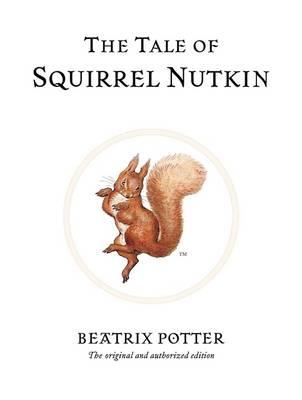
4. I've always enjoyed Squirrel Nutkin, not only for the interesting riddles it includes, but for the build-up of Nutkin's continuous "impertinence" (as the book puts it) toward Old Brown, the owl (in modern terms, he was an obnoxious twat). There is a certain sense of foreboding of what is eventually going to happen, and once again, Beatrix Potter does not hesitate to physically injure her characters in order to portray the dangers of overstepping the boundaries of nature.
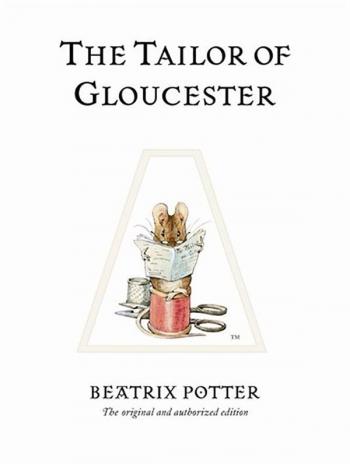
5. The Tailor of Gloucester is wordier than most of the other Potter tales, and so might appeal more to older children, but I really enjoyed it as a child, especially after watching an animated BBC version of the story (which retained the declaration, "No more twist!"). I remember feeling so bad for the tailor, and appreciated a story in which animals did something intelligent and helpful. It also makes a nice Christmas story, although the holiday itself doesn't play a major part in the book.


